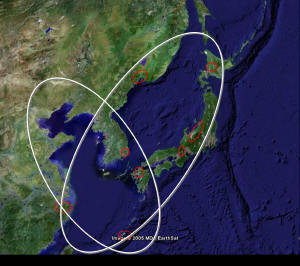Research areas of NEOMAP
The present project focuses mainly on the East Asian inland sea, i.e. the Japan Sea Rim and the East China Sea Rim (Fig. 1) shaped geologically by two great river systems: the Amur and Yellow River systems. East Asian inland sea region contains a remarkable cultural, climatic and environmental diversity ranging from the sub-boreal foraging cultures on Hokkaido and Russian Far East to the sub-tropical Oceanic cultures of the Ryukyu Islands. This allows for a comprehensive research of landscape changes under most diverse cultural and climatic conditions. Throughout the research the results would be compared to those of the landscape research on the North European inland seas through a series of common workshops and seminars.
Eight research areas where chosen on the East Asian inland seas to represent the full variety of cultures and natural settings. Each area had to fulfil following requirements:
(1) Be located on the border of various environments (mountains, inland water bodies, seas, plains etc) to guarantee maximum variety in land use, subsistence activities, species and cultural activities connected to them;
(2) Be important cultural or trading centres throughout history;
(3) Have important natural resources that would be traded with other communities or act as a doorway to mainland areas;
(4) Have important archaeological sites (preserved well, large scale, well researched) from Neolithic and pre-Neolithic period;
(5) Have an ample amount of historical records.
To foster inter-disciplinarity of the project, the research groups are divided according to the regions rather than by research subjects. The areas, research groups of the project and the main issues that could influence landscape development in given regions are as follows.
Mainland Japan
Marginal Japan
Continental areas
